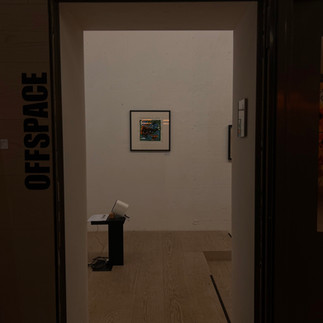The Science of Artistry: Thabiso and the Living Legacy of Botaki Factory
- Tallulah Patricia B
- Aug 29
- 6 min read
Updated: Aug 30
Today, I brought home my first Thabiso. It is not yet one of his monumental canvases. The kind that command entire walls, demand silence, and alter a room’s gravity, but it carries the same weight. To own even a fragment of his work is to hold a piece of history already in motion. Because Thabiso Phepeng is not only painting; he is mutating the cultural DNA of Switzerland, weaving African legacies into the very texture of Zurich.
A Lineage Older Than Modernism
Thabiso’s story begins with his grandmother, a healer of Ndebele and Pedi heritage in South Africa. Like the women of her community, she painted walls with bold geometry; circles, triangles, grids, radiant with primary color. These were not decorations, but rituals of continuity, a way of binding families to place and ancestors to descendants.
Decades later, in the lecture halls of Pretoria, Thabiso encountered these same patterns projected as European modernism. Bauhaus. Mondrian. Le Corbusier. What the academy praised as “innovation,” he recognized instantly as inheritance. His grandmother’s walls had carried it all along. This moment, at once recognition and erasure crystallised his vision: art is never neutral. It is memory, power, and the politics of who gets to claim authorship.
What Thabiso embodies is not “influence” from European modernism but its mirror reversal: the living roots of what modernism borrowed and renamed.
From Apartheid to Post-Apartheid to Diaspora
When Thabiso entered art school in the 1990s, South Africa was in transition. Apartheid had officially ended, but its cultural structures endured. Black students were nudged toward pottery, sculpture, or textiles, never realism or painting. These were coded as “white disciplines.” By choosing painting, Thabiso was refusing a hierarchy that told him where he belonged.
His practice carries this post-apartheid legacy: it is not only about creating images, but about reclaiming artistic freedom once denied. His canvases, with their layered abstraction and shifting registers, are fragments of a longer story. A story of a generation of artists who stepped into spaces their elders were barred from.

Now, bearing the hustle of working nightshifts to sustain his vocation of being an artist in Switzerland, Thabiso extends that trajectory into the diaspora. His art carries with it southern African memory while also conversing with Zurich’s own cultural fabric.
This is why his presence is so significant.
One day, when Zurich’s contemporary art scene is studied by future historians, Botaki Factory will appear as a turning point.
The moment when diasporic artists stopped waiting for permission and began shaping the city’s cultural movement from within.
The Botaki Movement
Botaki Factory, the collective Thabiso helped build, is more than a space. Its name, from Setswana, means “the science of making art.” And that is precisely what it is: a laboratory where art is created, studied, lived. In a transitional UBS real estate building, with a lease set to expire by end of 2025, month after month, Botaki hosts solo exhibitions. It runs on faith, improvisation, and community loyalty rather than institutional patronage. And yet, this fragility is its strength.
Because what Botaki is modeling is not survival, but sovereignty. It is showing that artists including diasporic artists in Switzerland can create institutions of their own. Institutions that will one day be remembered not as footnotes, but as foundations. Zurich has seen this before. What began as gatherings of outsiders, the overlooked or the experimental, have often defined the city’s cultural identity in retrospect. Dada was born in a cramped bar on Spiegelgasse, not in the marble halls of Kunsthaus. Independent publishing, experimental music, and activist theatre have all found their roots in improvised spaces before being written into Switzerland’s official narratives. Botaki stands in that lineage. The kind of fragile, unpolished ecosystem that later generations will point to as origin, not appendix.
When future students of art history look back at Zurich in the 2020s, they will not only study Kunsthaus or the satellites of Art Basel. They will study Botaki, and how it rewove the city’s cultural fabric from the margins inward.
The question is not whether Botaki will be remembered, but whether Zurich itself will recognize, in time, the significance of what is unfolding right now within its pristine walls.
Thabiso amid Zurich’s Cultural Landscape
To encounter Thabiso’s art now is to stand at the edge of inevitability. His breakthrough is not a question of if, but when. He is not only part of South African art history or post-apartheid legacy. He is part of a much larger arc: African art history, southern African memory, diaspora culture in Switzerland, and the very sociology of how communities build their own platforms in white-majority spaces.

Thabiso is already a piece of art history in motion. His work is layered. Visually, yes, but also anthropologically. Each canvas is a fragment of his grandmother’s inheritance, a conversation with modernism, a refusal of erasure, and a promise to future generations.
A Collector’s First Thabiso
Which is why today, bringing home my first Thabiso, feels monumental. For three years I have been manifesting one of his large-scale works (I even photoshopped it onto my mother’s living room wall, trying to sell her on a great investment opportunity..). One day, with bigger pockets, I surely will bring one home. But even now, this first piece holds the same gravity.
Because to collect Thabiso is not simply to buy a painting.
It is to participate in a lineage.
To sustain a movement before it becomes canonized.
To say yes to an artist whose work will one day be studied in art history or social anthropology courses not only in South Africa, but in Zurich, Paris, New York.
Thabiso is undeniably talented. His full breakthrough is looming. And when it comes, those of us who believed early will know what we held in our hands: a fragment of history, already alive, already luminous.
Botaki as Legacy in the Making
To speak of Thabiso is also to speak of Botaki Factory. His art does not end on the canvas. It spills outward, into walls, gatherings, and communities. Botaki is not a backdrop to his career; it is part of his work, a collective formation sculptured from trust, improvisation, and shared vision.
That vision now lives in an unlikely setting: a UBS branch at Albisriederplatz. The banking hall still serves clients, but the upper floors, left unutilised, have been transformed into a living gallery. Month after month, Botaki fills these rooms with solo exhibitions (currently hosting Marvin Kangsen) that pulse with experimentation and community. It runs not on the steady channels of institutional patronage, but on mutual respect, experimentation, friendships and loyalty. And yet, this fragility is its strength.
There is also a quiet irony and perhaps an opportunity here. UBS, Switzerland’s global banking giant, is one of the world’s foremost art patrons, the lead partner of Art Basel, underwriting visibility at the highest levels of the market. And yet, within the walls of one of its own properties, another cultural story is already unfolding.
Botaki’s.
The lease at Albisriederplatz runs until 2025 (for now). What happens next is unwritten. If UBS or any forward-looking patron were to recognize the cultural gem already alive in its building and secure studio space for Botaki’s future, they would not simply be supporting a local initiative. They would be anchoring a movement that will define how Zurich in the 2020s is remembered. Not only for its grand institutions and global fairs, but for the way a grassroots collective rewove the city’s cultural fabric from the margins inward.
And this invitation extends beyond UBS.
Zurich today is full of next-generation investors, philanthropists, and families of wealth who are asking themselves how to build legacies that matter. Supporting Botaki is not about short-term returns. It is about shaping a cultural inheritance that will endure. To back Botaki now is to claim a place in history as one of those who saw, early, what others overlooked.
Lastly, consider Basquiat. Today, his paintings command hundreds of millions at auction. But in his lifetime, he survived on fragile networks of patrons, friends and believers who gave him space, materials, and recognition before the market caught up. Those who stood beside him then are remembered not only as collectors, but as visionaries. The same question now stands before us in Zurich: who will be remembered as the ones who saw Thabiso and Botaki before the breakthrough?
Because perhaps Thabiso’s most profound artistry is not only what he paints, but what he builds. Through Botaki, he reminds us that art is not just what we hang on walls, but the worlds we dare to create together. Worlds that, with vision and recognition, will outlast us, and one day be called history...

If you want to be part of this story — to help ensure that Thabiso and Botaki not only survive but thrive — you can support their work directly here:
The Botaki Factory consists of following artists and members:
Juice Visual Artist / Poet - Thabiso Phepeng Visual Artist / Marvin Kangsen Visual Artist / Patrick Planter Photographic Artist / Andile Magengelele Curator / Exhibition maker Davina Gokool Member / Marlon Printer /Musician Stephanie Briers Member





























Thabiso Phepeng's work at Botaki Factory is a powerful testament to the fusion of tradition and innovation. His art not only bridges cultures but also invites us to reflect on our shared humanity. It's inspiring to see how spaces like Botaki Factory nurture such impactful creativity. Looking forward to witnessing more of this dynamic journey!